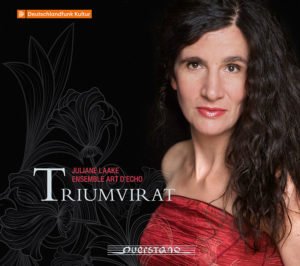Triumvirat
Music for viola da gamba from the era of Schenck, Kühnel & Höffler
Works by Johann Schenck, August Kühnel and Conrad Höffler
Juliane Laake
Ensemble Art d’Echo
VKJK 1815
Release 10.04.2019

Music for viola da gamba from the era of Schenck, Kühnel & Höffler
Works by Johann Schenck, August Kühnel and Conrad Höffler
Juliane Laake
Ensemble Art d’Echo
VKJK 1815
Release 10.04.2019
Johann Schenck (1660 until approx. 1712)
Overture 66 from Suite IX (from „Scherzi musicali”, 1698)
01 Adagio 02:06
02 Allegro 02:11
03 Adagio 00:42
04 Allabreve 01:20
05 Adagio 00:49
August Kühnel (1645 until approx. 1700)
Sonata II â 2 Viole da Gamba (from „Sonate ô Partite”, 1698)
06 o. T. (Preludio) 01:31
07 Aria 02:44
08 Allegro 01:29
09 Aria Allegro 02:18
10 Adagio 01:24
Johann Schenck
Sonata 4 solo (Mus.Hs.16.598, Vienna, ca. 1705)
11 Adagio* 02:21
12 Aria allegro* 01:50
13 Adagio 01:24
14 Adagio* 02:54
15 Gigue 01:44
* World premiere recording
Conrad Höffler (1647 – 1696)
Suite I (from „Primitiae Chelicae”, 1695)
16 Preludio 01:08
17 Fuga 02:29
18 Allemand 02:01
19 Courant 01:10
20 Saraband 02:04
21 Gigue 01:09
Johann Schenck
Sonata I (from „Le Nymphe di Rheno”, 1702)
22 Adagio 01:00
23 Presto 00:40
24 Adagio 01:23
25 Allemanda 03:33
26 Corrente 02:23
27 Sarabanda/Variatio 02:32
28 Giga 02:14
August Kühnel
Partita XIII (from „Sonate ô Partite”, 1698)
29 Preluda 01:31
30 Allemande 02:10
31 Corrente 01:32
32 Sarabande 02:36
33 Giga 01:17
Total time: 64:43
If, at the beginning of the 1600s, it was the English who were acknowledged to be experts and virtuosos of the viola da gamba, then it was the French who surpassed them by the middle of the century. They, in turn, had to share this status with the gambists working at German courts towards the end of the century, if not cede it to them.
At that time, Johann Schenck, August Kühnel and Conrad Höffler were well known to the musical world as gamba virtuosos and masters of their trade. But up against the lasting public relation campaign of a Sun King, whose brilliance also made his musicians, in particular, the court gambists Marin Marais and Antoine Forqueray, famous far beyond the borders of the countries and centuries, the gambists working at the comparatively small German courts back then were powerless.
Although their surviving works are no less elegant, virtuosic and idiomatic than their French counterparts, the fame of the creators of these musical works of art has faded – making it high time to put an end to this imbalance and give three great gambists and their exceptional masterpieces the attention they deserve!
The 3rd CD released by Juliane Laake and her ensemble Art d’Echo contains three sonatas, one overture, one suite and one partita written by the three aforementioned German gambists. Johann Schenck’s Sonata 4 solo is preserved as an autograph in the Austrian National Library, and it remains unclear how it found its way there. On the CD at hand, three of its five movements are recorded for the very first time.
Exciting Interpretation:
This recording demonstrates once again Juliane Laake’s exemplary command of gamba technique. She navigates the fast, lively movements with consummate dexterity, while the slow, emotional sections are enchantingly beautiful. In Kühnel’s Sonata for two gambas Júlia Vetö, the second player, shows equal skill. The Art d’Echo Ensemble with lutenist Johannes Gontarski and harpsichordist Carsten Lohff accompany with great empathy and in changing combinations. Bernhard Schrammek on rbb Kulturradio, 20.05.2019
Gamba music performed with such a sunny and gleaming quality gives its listeners an instant and heightened awareness of their own existence and enables them to dip into an Arcadian musical landscape far removed from all temporal concerns. As she plays, Juliane Laake, the “grande dame” of the viola da gamba, brings to life all the magic of lost or forgotten musical scores. Dr. I. Waltenberger, online merker, 15.09.2019
KLASSIK-HEUTE- recommendation 1010-10
Juliane Laake and her ensemble, especially her second gambist Júlia Vetö, bring to life these works from the German high baroque in all their fantastical wealth of invention and emotional variety, with flawlessly beautiful sound. Once one has heard this CD it is irrefutably clear that these baroque affects all derive from the deeply-felt feelings of an individual, common to all humanity yet expressed in new ways in every musical epoch. This effect is not, of course, achieved by exaggeration in the manner of presentation; what makes these interpretations so compelling is precisely the subordination of the performer’s personal emotional responses to an extreme sensitivity to the emotional content of the music. Klassik-heute.com, 15 May 2019